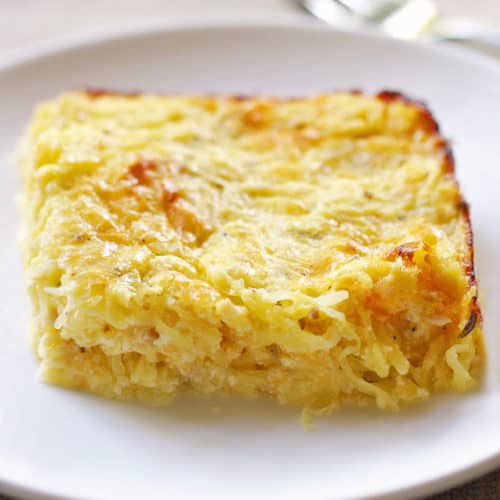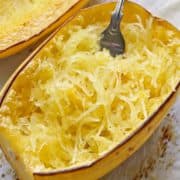While there are other methods for cooking this squash, oven-baking yields the best results in terms of texture and flavor. Winter squashes are the perfect cold-weather side dish - they are hearty, flavorful, and very filling. And when you season them right and roast them, or mash them with cream and butter, you no longer need to mourn your inability to eat potatoes.
Ingredients
You’ll only need four simple ingredients to make this spaghetti squash recipe. The exact measurements are listed in the recipe card below. Here’s an overview of what you’ll need: The way you can run a fork through its cooked flesh and create long, golden noodle-like strands - it’s magic! It’s truly one of the most fun squashes to eat, so I make it quite often. Spaghetti squash: I use a small 2-lb. one. If you use a larger one, you’ll need to adjust the cooking time. Olive oil: For convenience, I use an olive oil spray. To season: Kosher salt and black pepper.
Instructions
There are several ways you can cook this magical squash. All of them work well, and each of them has its advantages and its drawbacks.
- Microwave. You can microwave spaghetti squash. This is probably the easiest method because it saves you from the task of cutting a raw squash. You simply pierce it with a fork, then microwave it whole until it’s fork-tender. The drawback of this method is that the strands it produces tend to be on the mushy side.
- Bake it in a water bath. In this method, you cut the squash, then place the halves, cut side down, in a rimmed 9 X 13 baking dish. Add enough water to come ½ inch up the sides of the baking dish. Cover with foil and bake until tender, about 45 minutes. This method produces a reliably tender, uniformly cooked squash.
- Oven-bake. This brings me to the method outlined here, of baking the spaghetti squash directly on a baking sheet. For this method, you cut the squash, then place it cut side down on greased parchment paper (or you can lightly grease the squash itself). As before, bake until tender, about 40 minutes in a 425°F oven. The third method yields the best texture. The squash comes out perfectly cooked, golden brown and fragrant, and when its flesh is raked back and forth with a fork, the strands are just right - soft but not mushy.
Expert tip
The need to cut the squash prior to baking is exactly why I often choose the microwave method, which saves me from cutting it raw. It’s not easy to cut squashes - their skin is thick and hard. You need to be very careful when doing it. One trick I have learned over the years is to microwave the squash for just a minute or two, depending on its size. This ever so slightly softens the skin, making the task of cutting it less onerous. Once you’ve slightly softened the skin, but without actually cooking the squash, place it on a sturdy cutting board, and work very carefully. First, using a large, freshly sharpened knife, slice off the stem end of the squash. Then stand the squash upright on that flat end and carefully use the knife to slice it in half lengthwise. Phew! That was the difficult part, but you’re still left with the slightly annoying task of removing the pulp and seeds - do that with a large metal spoon, as shown in the video below.
Frequently asked questions
Variations
The best way to vary this recipe is to add more spices. So rather than seasoning the squash with just salt and pepper, you can add some garlic granules and dried thyme, for example. You can also brush it with melted butter prior to baking in lieu of using olive oil.
Serving suggestions
You can simply enjoy the squash as is as a side dish - and if that’s what you plan on doing, you might want to brush it with melted butter and sprinkle it with salt and pepper prior to baking. You can also top the strands with meatballs or a meat sauce, or use them as a bed for all sorts of saucy dishes such as beef stroganoff or pulled chicken.
Storing leftovers
Like most cooked leftovers, you can keep the cooked squash strands in the fridge, in an airtight container, for 3-4 days. They keep quite well and also reheat well. If you’re not going to use them in another recipe, you can simply reheat them in the microwave.
Related recipes
👩🏻🍳 I typically publish a new or an updated recipe once a week. Want these recipes in your inbox? Subscribe! You can unsubscribe at any time.
Recipe card
❤️ Let’s connect! Follow me on Pinterest, Facebook, TikTok, YouTube, Instagram, or Twitter.













